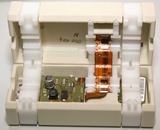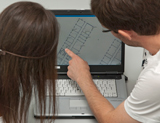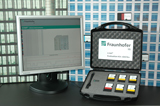Energy monitoring and smart metering reduce industrial and household energy consumption
Fraunhofer Institute for Integrated Circuits IIS will be presenting two highperformance metering solutions at the Metering Europe, October 9 to 11, booth E06 in Amsterdam. The energy consumption in the industrial and manufacturing sectors as well as in private homes can be accurately measured and reduced.



The energy savings potential of particularly medium-sized and energy-intensive industries is far from being exhausted. Often there is little or no information on the exact energy consumption of manufacturing equipment. New legislation for energy management systems, like the DIN EN ISO 50001 standard, which has been effective since late 2011, imposes the binding obligation on companies to report and publish their energy efficiency measures, and specifies new requirements for a detailed energy demand assessment throughout the manufacturing process.
Novel current sensor measures performance of large electrical appliances
Fraunhofer IIS found the ideal solution: since March 2010 and in collaboration with Rauschert GmbH, the scientists have developed a new metering system to continuously capture the consumption per circuit with highest accuracy. The measuring modules are installed directly in the distribution box of the manufacturing machinery. The research project is funded by the Bavarian Ministry of Economic Affairs, Infrastructure, Transport and Technology as part of its Microsystems Technology program.
Tried and tested: Radio-based metering with s-net®
Consumption-based rates, automated reading and accurate consumption prognosis – child’s play with the s-net® wireless sensor networks for smart metering. The s-net® technology allows for the integration of existing simple, radio-based as well as wired metering systems into a multi-hop communication network for the transmission of consumption data as well as the realization of new, intelligent meter readout systems. The s-net® technology can be combined with other wireless radio-based protocols like e. g. wireless M-Bus. The s-net® technology easily adjusts to the diverse range of meters and metering protocols with flexible interfaces. This way, the utility companies, municipal utilities and meter manufacturers can develop solutions, which enable a unique proposition in the markets. The evaluation kit DATA is used to test the s-net® technology on site.
Novel current sensor measures performance of large electrical appliances
Fraunhofer IIS developed a sensor ASIC, which measures the consumption of remote appliances. The network quality parameters can be monitored to help rapidly identify problems during production.
The novel current sensor measures the magnetic field in tangential direction to the surface of the chip and transmits the recorded data via optimized serial data transmission to a microcontroller. Here the measured data of the individual sensors are processed to derive the measurement value for the current in the conductor. Insulationpiercing screws permit the measurement of the voltage. The sensor system is extremely easy to install; the metering unit can be simply clipped onto a conductor like a laundry peg.
s-net® Technology
The characteristics of the s-net® technology for wireless sensor networks are unequalled. It offers the key components for smart metering solutions: Licensable hardware design for the radio nodes in the meter, individually adjustable networking protocol software, as well as service and application components. The s-net® technology reacts with great flexibility to legal regulations regarding metering.
The s-net® communication protocol allows for autarkic battery operated large-scale s-net® networks with low latency properties. The dynamic network structure and self-organizing topology require minimum configuration effort and maintenance while providing a high level of robustness. Bidirectional multi-hop communication eliminates range restrictions of radio cells. Meter readings, instructions or control commands, like e. g. transmission of the latest rates, closing of the valve, are sent to the individual smart meters via various radio nodes.
For more, please go to www.s-net-info.com